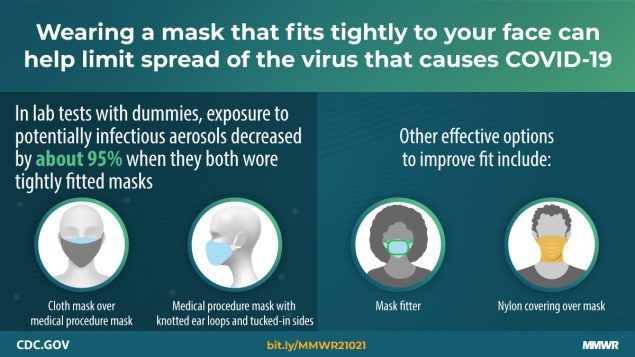In a new report released Wednesday, the Centers for Disease Control and Prevention published research that supports the idea of "double masking" and wearing masks that are fit tightly around the face, both of which could significantly reduce the spread of the coronavirus.
They also found that droplets were better blocked when two subjects in the same room both have a well-fitted face covering, reducing exposure by about 96% in both cases.
Still, the CDC has not formally recommended wearing two masks, though the agency's director said Wednesday that they would issue new guidelines on how to improve a mask's fit.
In one January experiment, CDC researchers evaluated the benefit of "double masking," or layering a cloth mask on top of a medical procedure mask. They tested the masks on dummies and in a lab, where they used droplets that mimicked COVID-19 particles.
They found that both masks worn together blocked 92.5% of particles from a simulated cough, more than double what each mask blocked on its own. Researchers found that a loose-fitting, medical procedure mask blocked 42% of particles on its own and a cloth mask blocked about 44%.

"Masks can be cumbersome, they can be inconvenient," CDC Director Dr. Rochelle Walensky said in a White House COVID-19 briefing Wednesday. "The science is clear. Everyone needs to be wearing a mask when they are in public or when they are in their own home but with people who do not live in their household."
CDC researchers then looked at the benefits of wearing a tightly-fitted mask, which they found also helped reduce the spread of virus particles.
They made medical masks tighter by knotting the ear loops of the mask to make it fit more closely to the face, plus tucking extra mask fabric to prevent gaps on either side, as demonstrated in a University of North Carolina Health video linked by the CDC.
Researchers found that the knotted and tucked mask reduced exposure by at least 60% when only one subject was wearing it, and the fitted mask reduced exposure by nearly 96% when both dummies wore the face covering.
"We continue to recommend that masks should have two or more layers completely covering your nose and mouth and fit snugly against your nose and the size of your face," Dr. Walensky said Wednesday.
"Based on this new information, the CDC is updating the mask information for the public on the CDC website to provide new options on how to improve mask fit," she added. "The bottom line is this: Masks work, and they work best when they have a good fit and are worn correctly."
Already, the CDC has required that masks be worn on all transportation and transportation hubs, including airports, airplanes, buses, trains, and metro systems. President Joe Biden also signed an executive order on his first day in office that required masks on all federal property.



